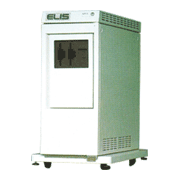ELIS was a LISP machine developed by NTT at the end of the Nippon Telegraph and Telephone Public Corporation era (1985). The name "ELIS" derived from NTT's Electrical Communication Laboratories (ECL) and stood for Ecl LISt processor. This was a revival of a name used for a list processing system created by Ikeno Nobuichi in 1966.
At the time, the dominant idea was that, if you were going to create a LISP machine, it must a large, true LISP machine. On the other hand, the 1980s marked the advent of VLSI, and NTT moved ahead with a project to develop VLSI. Hibino Yasushi (who worked at the time at the Musashino Electrical Communication Laboratories of Nippon Telegraph and Telephone Public Corporation) believed that, if a LISP machine is to be built with single-chip LSI, it must be developed from the beginning with an eye on the eventual conversion to LSI. His first idea as a formal structure for the LSI was memory general-purpose registers (MGRs). The approach was to provide multiple registers to access cells (which are the units of list structures) and then use these as the source and destination registers of computing elements. MGRs would become both memory data registers and address registers. This would make it possible not only to continuously perform memory operations and arithmetic/logic operations, but also perform arithmetic/logic operation and memory operations simultaneously.
In establishing the detailed architecture, the basic approach was to "essentially, use the same circuit to implement the same function". The various capabilities necessary for LISP processing were integrated around the MGRs, and functions like simultaneous reading of CAR/CDR, removal and insertion of 1 and 2 byte characters, and tag determination/setting were implemented around the MGRs and computing elements.
Work on ELIS began in 1978. Conversion to LSI was attempted at the Musashino Laboratories starting in 1982. In the fall of 1983, the prototype LSI was partially in operation, and the TAO/ELIS multi-paradigm language processing system (developed by Takeuchi Ikuo et al.) was also launched at this same time. TAO was not simply LISP. Its distinguishing feature was that it handled 3 programming paradigms (logic programming, and object-oriented and function-based LISP) in a unified fashion within an S-type syntax. While the conversion to LSI was underway, Takeuchi et al. worked toward the goal of coding a microcode-based TAO interpreter exceeding 20 kilosteps. The prototype machine was named "Hydrogen". On September 9, 1983, a process was established for very large 25mm2 chips. On that same day, the TAO processing system began running on the prototype machine.
Practical research began at the Yokosuka Laboratories starting in 1985. Commercial LSI was developed with the cooperation of Oki Electric Industry, and the machine was announced as an AI workstation in 1986. A paper on ELIS was announced at ISSC in 1987, at the same time as a LISP chip from TI.
The NTT-IT Corporation was established in 1987, and the machine was marketed as the ELIS-8100. Development of a successor (ELIS-8200) began immediately. NTT-IT also developed the board type ELIS-VME for built-in use. The ELIS-8200 was marketed in 1989. After 1991, NTT-IT began to withdraw from the ELIS business, and their withdrawal was completed in 1993.
βi(Compiled from: Hibino, Yasushi: "ECL ELIS", Information Processing, Vol. 43, No. 2, pp. 118-120 (2002).)


